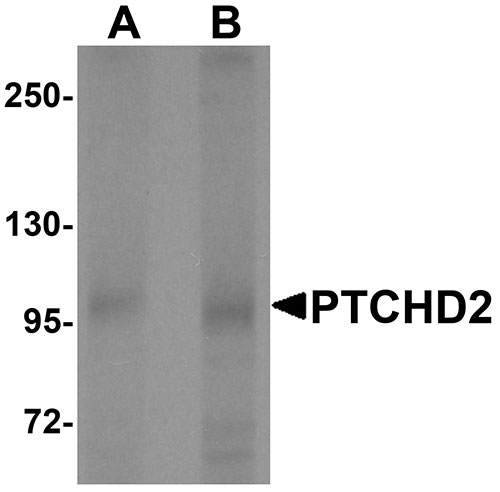PTCHD2 Antibody
- SPECIFICATION
- CITATIONS
- PROTOCOLS
- BACKGROUND

Application
| WB, IHC-P, IF, E |
|---|---|
| Primary Accession | Q9P2K9 |
| Other Accession | Q9P2K9, 149274653 |
| Reactivity | Human, Mouse, Rat |
| Host | Rabbit |
| Clonality | Polyclonal |
| Isotype | IgG |
| Calculated MW | 153048 Da |
| Application Notes | PTCHD2 antibody can be used for detection of EPAC1 by Western blot at 1 - 2 µg/mL. Antibody can also be used for immunohistochemistry starting at 2.5 µg/mL. For immunofluorescence start at 20 µg/mL. |
| Gene ID | 57540 |
|---|---|
| Target/Specificity | PTCHD2; At least two isoforms of PTCHD2 are known to exist. This antibody is specific for PTCHD2 and will not recognize the other DISP family of proteins. |
| Reconstitution & Storage | PTCHD2 antibody can be stored at 4℃ for three months and -20℃, stable for up to one year. As with all antibodies care should be taken to avoid repeated freeze thaw cycles. Antibodies should not be exposed to prolonged high temperatures. |
| Precautions | PTCHD2 Antibody is for research use only and not for use in diagnostic or therapeutic procedures. |
| Name | DISP3 {ECO:0000303|PubMed:15645143, ECO:0000312|HGNC:HGNC:29251} |
|---|---|
| Function | Plays a role in neuronal proliferation and differentiation (PubMed:25281927). Plays a role in the accumulation of cellular cholesterol (By similarity). Involved in intracellular lipid droplet formation (PubMed:25281927). May contribute to cholesterol homeostasis in neuronal cells (By similarity). |
| Cellular Location | Endoplasmic reticulum membrane; Multi-pass membrane protein. Nucleus membrane; Multi- pass membrane protein. Cytoplasmic vesicle membrane {ECO:0000250|UniProtKB:B9U3F2}; Multi-pass membrane protein. Note=Predominantly localized to cholesterol-enriched domains within the membrane (PubMed:19179482). Localizes to cytoplasmic punctate vesicular structures (By similarity) {ECO:0000250|UniProtKB:B9U3F2, ECO:0000269|PubMed:19179482} |
| Tissue Location | Expressed in brain and testis (PubMed:15645143). |

Thousands of laboratories across the world have published research that depended on the performance of antibodies from Abcepta to advance their research. Check out links to articles that cite our products in major peer-reviewed journals, organized by research category.
info@abcepta.com, and receive a free "I Love Antibodies" mug.
Provided below are standard protocols that you may find useful for product applications.
Background
PTCHD2 Antibody: PTCHD2, also known as DISP3, is the third of three known homologs of the D. melanogaster protein Dispatched. It is a multi-transmembrane protein containing two PTCH/DISP domains and is thought to be involved in the release of lipid-anchored secreted proteins. Like DISP1 and DISP2, DISP3 has been implicated in signaling pathways during embryogenesis, tissue regeneration, and carcinogenesis. It is highly expressed in Purkinje cells, hippocampal neurons, and retinal ganglion cells. Recently, it has been shown that PTCHD2 localizes within the endoplasmic reticulum and colocalizes with cholesterol, and given that its expression is regulated by thyroid hormone (T3), it has been suggested that DISP3 may be a link between thyroid hormone and cholesterol metabolism.
References
Katoh Y and Katoh M. Identification and characterization of DISP3 gene in silico. Int. J. Oncol. 2005; 26:551-6
Katoh Y and Katoh M. Hedgehog signaling pathway and gastric cancer. Can. Biol. & Ther. 2005; 4:1050-4
Zikova M, Corlett A, Bendova Z, et al. DISP3, a sterol-sensing domain-containing protein that links thyroid hormone action and cholesterol metabolism. Mol. Endocrin. 2009; 23:520-8.
If you have used an Abcepta product and would like to share how it has performed, please click on the "Submit Review" button and provide the requested information. Our staff will examine and post your review and contact you if needed.
If you have any additional inquiries please email technical services at tech@abcepta.com.













 Foundational characteristics of cancer include proliferation, angiogenesis, migration, evasion of apoptosis, and cellular immortality. Find key markers for these cellular processes and antibodies to detect them.
Foundational characteristics of cancer include proliferation, angiogenesis, migration, evasion of apoptosis, and cellular immortality. Find key markers for these cellular processes and antibodies to detect them. The SUMOplot™ Analysis Program predicts and scores sumoylation sites in your protein. SUMOylation is a post-translational modification involved in various cellular processes, such as nuclear-cytosolic transport, transcriptional regulation, apoptosis, protein stability, response to stress, and progression through the cell cycle.
The SUMOplot™ Analysis Program predicts and scores sumoylation sites in your protein. SUMOylation is a post-translational modification involved in various cellular processes, such as nuclear-cytosolic transport, transcriptional regulation, apoptosis, protein stability, response to stress, and progression through the cell cycle. The Autophagy Receptor Motif Plotter predicts and scores autophagy receptor binding sites in your protein. Identifying proteins connected to this pathway is critical to understanding the role of autophagy in physiological as well as pathological processes such as development, differentiation, neurodegenerative diseases, stress, infection, and cancer.
The Autophagy Receptor Motif Plotter predicts and scores autophagy receptor binding sites in your protein. Identifying proteins connected to this pathway is critical to understanding the role of autophagy in physiological as well as pathological processes such as development, differentiation, neurodegenerative diseases, stress, infection, and cancer.




